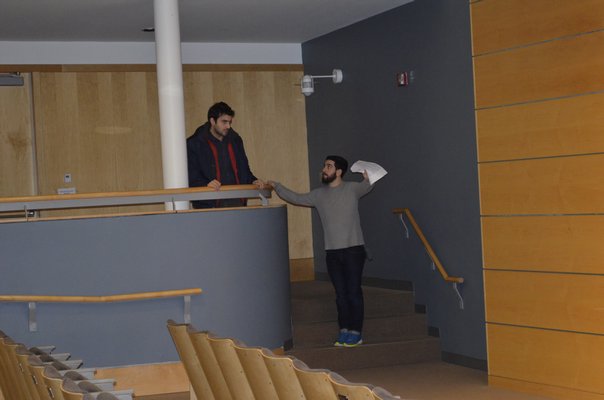
Some lights. One camera. Natural action.
Those are the simplified rules of the Dogme ’95 avant-garde filmmaking movement, launched almost two decades ago by Danish directors Lars von Trier and Thomas Vinterberg. The participants vowed to create films based on traditional values—story, acting and theme—and shun special effects, taking power away from the corporate studios and handing it back to the artists.
The movement officially died in 2005. But it has been reawakened.
This week, digital filmmaking graduate students at Stony Brook Southampton are shooting their course’s culmination—seven interlocking short films in the Dogme style—led by associate professor Magdalene Brandeis and Lenny Crooks, one of the early collaborators of the Dogme ’95 movement and, currently, a development consultant for Killer Films.
“We wanted to get rid of the plot-driven approach,” Ms. Brandeis said on Sunday afternoon, taking a break from the shoot on campus. “We wanted to emphasize storytelling, as opposed to the gadgets and gizmos of modern movie-making.”
Shot with one camera, sans tripod, a single microphone and natural light, the completed 50-minute project will be without the “tricks” of the editing process, Mr. Crooks explained on set, including artificial light, re-recorded audio, transitions and even makeup.
The key to a successful Dogme work, he said, is the creation of authentic characters—no superficial action, car chases, or gratuitous killing allowed. “The characters, if they are strong enough and believable enough,” Mr. Crooks said, “will tell the story.”
This particular story, however, remains a mystery. The only clues are the title, “How to Write A Killer Résumé,” and a basic plotline: seven misfits from present-day Southampton are brought together once a week for a résumé-writing class.
“I don’t want to corral this story line into one direction,” Mr. Crooks said, “because it could have gone in seven different directions.”
The program’s seven students created each of the film’s characters for a previous project, Ms. Brandeis explained, before pairing up to write two of the final seven episodes that will be shot consecutively over the course of a week. Each student will direct one episode with 10 hours to shoot.
Melissa Bank, author of “The Girls’ Guide to Hunting and Fishing,” and Patricia Marx, staff writer for The New Yorker, also contributed to the project by co-writing the first and last episodes, respectively, alongside the students.
“All that mattered was that each pairing evolved the story,” Mr. Crooks said of the student collaboration. “Even if it wasn’t a narrative arc, it would still be an interesting sequence of events.”
This isn’t the first time the MFA program has attempted this sort of endeavor. Last year, the “20/20/20 Project” featured 20 filmmakers making 20 movies in 20 days. It was only natural for the idea to evolve and expand, Ms. Brandeis said.
“I was thrilled to know [Mr. Crooks] had experience with the [Dogme] movement,” Ms. Brandeis said. “We knew we had to give this a try.”
Mr. Crooks, who worked in Denmark during the Dogme movement, said the style of the 20/20/20 Project reminded him of the challenges and demands presented to the creators and those involved in the era of Dogme. Taking away the gimmicks and flashing lights actually allows the artists to be more creative and focus on the heart of the work—its characters—while removing the ability to string together the action artificially, like many modern Hollywood films do.
“The idea that things are happening naturally in those movies is simply not true,” he continued. “There are so many things that have been manipulated and reworked to make you think that it’s natural.”